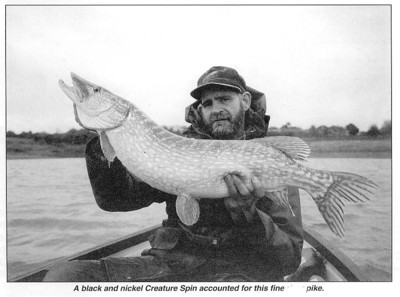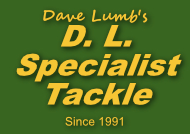This
rig-up should serve for most situations, but if the hook shank is short, or you
find that you are missing takes, it can be worth adding a stinger treble to the
set-up. All you have to do is pass the point of the jig hook through the eye of
the treble so that two points face upwards and the third can be stuck in the bait.
A short piece of thick-walled, fine bore rubber tube is pushed over the point
of the jig hook to prevent the treble coming loose. Alternatively, you could use
aquarium tube over the eye of the treble, and push the point of the jig hook through
that. Rigging the treble this way keeps it uppermost on the lure as you fish,
and therefore keeps the lure relatively weed and snag-resistant.
LARGE BAITS
On large soft
plastic baits, such as shad bodies, it is possible to wire in one or two trebles
to nick into the flanks of the bait. Run the wire from the eye of the jig hook,
or make separate rigs to clip onto the snap link of your trace. Most soft plastics
work best, in terms of their action, when unencumbered by hooks other than the
jig hook. So there is always an element of compromise between action and hook-ups
in rigging them up.
CUT BACKS
When using large grubs and reapers in particular,
you can cut the bait back from the 'head' end so as to shorten the body length.
This then puts the hook point in a better position. Don't worry about doing this
- it might look untidy, but it will help you connect with more pike. While on
the subject of modifying soft plastics, it is also possible to cut lures up and
weld them back together with a lighter or candle flame. You can cut the tail off
a chartreuse Creature, say, and weld it onto the black body of another to make
a two-tone bait. This is easiest done at home using a sharp knife to make the
cuts and a candle to provide the flame. When out fishing a disposable lighter
is the jig-man's saviour as it can also be used to repair soft plastics that are
getting well chewed.
One final rig
that I use is what I call the Swimming Rig. This is an un-weighted jig hook fitted
with a treble hook stinger on the shank and a keeper pin on the eye. I use this
rig for fishing soft plastics in shallow water, or over weeds where even a swimmer
head jig would drag the lure too deep too quickly. Swimming Rigs work great on
large grubs when fished with a steady retrieve.
What
is it that makes jigs worth using for pike? The simplest answer is that they are
something different. Faced with a water where the pike have seen all the usual
jerkbaits, spinnerbaits and so on, jigs are totally unlike any of these. Similarly,
if you have been pounding a spot for a couple of hours, maybe catching at the
outset, switch to a jig and there is a good chance that you will start picking
up fish again. This has been the case far too often for it to be mere coincidence.
When fishing a hot spot that cools off it isn't always the case that the pike
have moved out, or stopped feeding. They might simply have had enough of the pounding
and come to realise that the lures being used mean trouble. Throw a jig at them
and they become catchable again.

SUBTLE STYLE
When pike slow
down in winter they can often be caught on jigs when all else fails. Jigs are
subtle, and even in coloured water will pick up pike, maybe because you can work
them right along the bottom and bounce them off the pike's snouts, I don't know.
All I do know is that small(ish) they maybe, and unobtrusive too, yet when the
pike are playing hard to get, jigs can often save the day. Speed might have an
important part to play in the success rate of jigs on dour days. A jig can be
hopped along the bottom far more slowly than most other lures could be effectively
fished without the risk of snagging up. The single hook of a jig is as snag-resistant
as you can get, and using a stand-up jig will keep the hook point up too. I don't
pretend that this is a foolproof arrangement, but it is pretty reliable. In any
case, each hop will lift the bait off the bottom and jump it over minor snags.
Okay, jig heads can, and do, get pretty chewed up by rocks and so forth. But so
what? For fishing deeper than eight feet or so, I find that jig heads of an ounce
and upwards are easiest to use in order to maintain bottom contact. Lighter heads
can be easily controlled in shallower situations.
Despite
the name 'jig', I have found that the best way to fish these lures close to the
bottom is not to jig them with up-and-down movements of the rod tip - this is
too violent an action and it is difficult to keep the line tight as the jig drops
back. It is far better to work the lure off the reel. After letting the jig sink
to the bottom, keep the rod pointing down the line, crank the handle two or three
turns, then pause. A couple more cranks and pause. Repeat this procedure until
the lure is close in then rip it up in the water with the rod, let it drop back
a little on a tight line and then wind it in ready for the next cast. By varying
the speed and number of cranks between pauses, and the length of the pauses themselves,
you can achieve a wide range of presentations. One hidden extra to jig fishing
like this is that you can do it effectively while sat down! When casting from
a boat I am sure that this is a boon on certain days. Standing up you present
a large silhouette against the skyline to the pike, but sat down they might only
see the boat, and that is something that they rarely worry about. Just a thought.
KEEPING CONTROL
It isn't
always essential to maintain continual bottom contact when using jigs and plastics.
This may well be where they have the big advantage over other lures, but they
can also be used to offer a subtle presentation in mid-water. When fishing at
mid-water it can be okay to use the rod to work the lure and you can use a similar
action as you might to fish a spoon - sideways sweeps of the rod to move the jig
forwards and pauses to let it drop. You could use the upward flicks usually associated
with jigging, but I have found takes difficult to hit when fishing like this;
probably because this encourages slack line, and the jig can be ejected before
you have time to react.
You can also
fish jigs in mid-water by working the lure with the reel, but in order to keep
the bait up the process is speeded up a little compared to hopping baits along
the bottom. Reapers, Creatures and grubs all work fished up in the water on a
hesitant retrieve. Grubs, however, can be fished very successfully on a steady
crank as the rippling tail provides a visually attractive action. For off bottom
jig fishing I recommend a head weight of half to one ounce, and a swimmer head
will make life easier, particularly in shallow water owing to its slower fall
rate.
FOOLING FOLLOWERS
Sometimes
when fishing a jig in mid-water you will get pike following the lure in, as you
will with any lure at times. There is one trick that you can try with a soft plastic
bait on a jig that has never worked for me on any other lure type, and that is
to let it sink to the bottom and leave it there. Especially when using stand-up
jigs, but also with other styles, pike will eye up soft plastic baits that are
resting on the bottom, and after a few seconds decide to take them. The take is
not a violent affair, the jig is simply sucked into the pike's mouth. Watching
this happen is quite fantastic, and has made me wonder how often, and for how
long, pike might sit looking at legered deadbaits without taking them!
JIG VARIATIONS
There are
a couple of variations on the jig theme that are worth mentioning here, as they
are best fished with the same techniques. One is really no more than a modified
soft plastic bait. Now the Curtis Creature is a preposterous looking bit
of plastic to start with - at least a Reaper has something of an eel about it!
I came across the following modification in a musky fishing book, and it involves
the removal of the paddle tail from a Creature and its replacement with a spinner
blade. After cutting off the tail you sew a small snap-link swivel onto the stump
that is left with strong thread (I use 301b braid) and after tying off and trimming
the thread soak it in superglue. Then attach a number six Colorado blade to the
snap and off you go. Mounted on a jig you have what looks to me like a back-to-front
spinner, with the body in front of the blade. Still, bizarre though it might look,
it works. Fish the Creature Spin at midwater as previously described and throw
in a few longer pauses to let the bait drop, spinning its tail as it goes. Needless
to say, there is scope for varying the blade style and colour, and even trying
this modification on other soft plastics.
CREATURE
COMBO
This combination of a soft plastic bait
and a spinning blade is also available in another lure type that actually looks
more like a spinnerbait. This is the jigspin. These lures really are no more
than jigs fitted with L-shaped wire frames, with a spinning blade on the shorter
arm. Rather than fishing these lures as if they were spinnerbaits, my advice is
to use them in situations where you might opt for a jig, and fish them in a similar
manner. That is to say, clip one on when the pike have seen it all or are particularly
reluctant to come up off the bottom. I have even caught on a jigspin when literally
jigging it up and down at the side of the boat, fishing it from the bottom to
about a foot higher, keeping a tight line all the time. I will be quite honest
and admit that I was only doing this in order to keep a lure in the water while
I drank a brew! It just goes to show that you should never write any method off
as a waste of time. There is no doubt in my mind that jigs and soft plastics are
not a waste of time.

